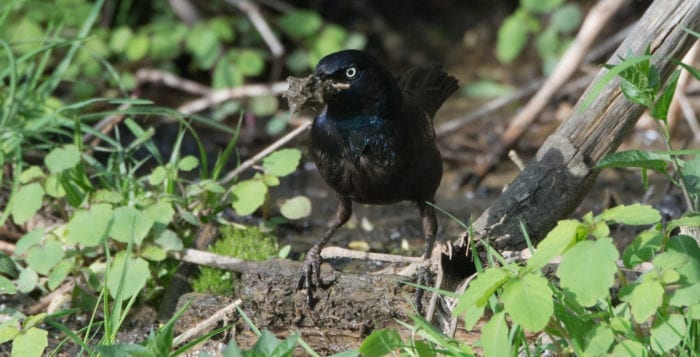Your Turn: Garrulous grackles

By John Turner
As the famous philosopher Yogi Berra once said, “You can observe a lot by just watching,” and between the passage of the 2,018 common nighthawks we tallied over the 41 days of the 2018 season at the Stone Bridge Nighthawk Watch, we had plenty of time to watch and observe.
One of those observations involved the daily movement of large mixed-blackbird flocks, flying north each evening, their destination being the communal nightly roost they established in the reed (Phragmites) beds at the southern edge of Conscience Bay, just north of the Grist Mill in Frank Melville Memorial Park in Setauket.
Joined by European starlings, red-winged blackbirds and brown-headed cowbirds, the flocks, numerically dominated by common grackles, would stream over us at the Stone Bridge and then, as they passed over the northern bridge at the northern end of the pond, descend abruptly to land on the narrow and slightly arching stalks of the Phragmites.
Their predictable movement each night of the Nighthawk Watch reminded me of another characterization, this one by the famous scientist Rachel Carson, who described the regular movement of birds such as these blackbird flocks as “faithful commuters” in the sky.
As they flew over us, the members of the flock vocalized continuously with quick sharp calls and we wondered why they might do that. One answer for the continuous calling may be a way for a bird in a flock to let neighboring birds — in front, behind and to the sides — know of its presence, helping to maintain a buffer between the birds, thereby reducing the chance of collisions.
Maintaining this space is vital given the fact the several dozen to several hundred members of the blackbird flock are moving through the sky together, at 20-30 miles per hour, separated by mere inches. Makes you wish drivers on the Long Island Expressway were so talented, no?
One evening recently my wife Georgia and I walked to the north bridge to watch the blackbirds spill from the sky into the reeds. They descended into the marsh on both sides of the meandering tidal creek that flows from the spillway at the bridge. A constant cacophony of squeaks (one call sounds like a rusty gate opening), rasps and whistles filled the air as the birds called incessantly. Having landed, the grackles and other blackbird species must now be vocalizing for a different reason, but frankly we have no idea.
Scientists conjecture that crows murmuring together at the end of a day in a winter communal roost do so to exchange information about the day they just experienced, such as what predators they encountered and food sources discovered. Could this be at least a partial answer to explain the thousands of garrulous grackles vocalizing into early evening, as they settle in to sleep for the night in the marshes of Frank Melville Park? Could there be other reasons? Maybe, but we just don’t know.
I often encounter grackles in different settings, as evidenced by a recent walk in the county park just north of the Sherwood-Jayne House. Heading up the west side of the property, I came to an opening in the forest where a small flock of 20 to 25 grackles was feeding on the ground. They systematically flipped over leaves, pieces of bark and other woodland debris searching with their beautiful golden-yellow, black-centered eye, for food which for them consists of a variety of small insects, other invertebrates like slugs and worms, caterpillars, small salamanders and fruits and seeds, which collectively make up their omnivorous lifestyle.
If you are an astute observer of grackles you might notice that adult birds vary in their coloration. Not surprisingly, males are showier than the females, their plumage infused with a purplish iridescence. But you might occasionally see, especially during the colder months, individual grackles tending to have more of a bronzy-colored tint to their feathers, rather than purple. The latter bird is referred to as the “bronzed grackle” while the former is the “purple grackle.” For many years they were considered different species but are now recognized for what they are — interbreeding color morphs of the same species.
If you leave the friendly confines of the Three Village area and travel to the Island’s South Shore, you might encounter another grackle species native to Long Island — the boat-tailed grackle. This larger species, a breeder amid the salt marshes of the South Shore bays, gets its name from the keel shape tail tip of the bird, quite visible when a male flies directly away from you.
Want to experience grackles and their blackbird brethren closer to home though? Just head to the bridge next to the Grist Mill in Frank Melville Park (www.frankmelvillepark.org) as dusk descends on an autumn day and face north toward the dense phalanx of reeds. If your senses aren’t overloaded by the sound and movement, perhaps you can figure out what the birds are saying to each other.
John Turner, a Setauket resident, is conservation chair of the Four Harbors Audubon Society, author of “Exploring the Other Island: A Seasonal Nature Guide to Long Island” and president of Alula Birding & Natural History Tours.






